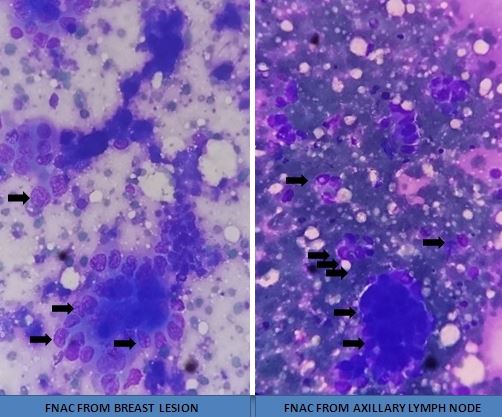[1]
Yii N,Read T,Tan CC,Ng SL,Bennett I, Diagnosing phyllodes tumours of the breast: how successful are our current preoperative assessment modalities? ANZ journal of surgery. 2018 Oct;
[PubMed PMID: 30141271]
[2]
Brennan SB,D'Alessio D,Kaplan J,Edelweiss M,Heerdt AS,Morris EA, Positive predictive value of biopsy of palpable masses following mastectomy. The breast journal. 2018 Sep;
[PubMed PMID: 30033648]
[3]
Jairajpuri ZS,Jetley S,Rana S,Khetrapal S,Khan S,Hassan MJ, Diagnostic challenges of tubercular lesions of breast. Journal of laboratory physicians. 2018 Apr-Jun;
[PubMed PMID: 29692584]
[4]
Mišković J,Zorić A,Radić Mišković H,Šoljić V, Diagnostic Value of Fine Needle Aspiration Cytology for Breast Tumors Acta clinica Croatica. 2016 Dec;
[PubMed PMID: 29117654]
[5]
Ibikunle DE,Omotayo JA,Ariyibi OO, Fine needle aspiration cytology of breast lumps with histopathologic correlation in Owo, Ondo State, Nigeria: a five-year review. Ghana medical journal. 2017 Mar;
[PubMed PMID: 28959065]
[6]
Shirian S,Daneshbod Y,Haghpanah S,Khademi B,Noorbakhsh F,Ghaemi A,Mosayebi Z, Spectrum of pediatric tumors diagnosed by fine-needle aspiration cytology. Medicine. 2017 Feb;
[PubMed PMID: 28178123]
[7]
Giamanco NM,Jee YH,Wellstein A,Shriver CD,Summers TA,Baron J, Midkine and pleiotrophin concentrations in needle biopsies of breast and lung masses. Cancer biomarkers : section A of Disease markers. 2017 Sep 7;
[PubMed PMID: 28946562]
[8]
Ahmadinejad M,Hajimaghsoudi L,Pouryaghobi SM,Ahmadinejad I,Ahmadi K, Diagnostic Value of Fine-Needle Aspiration Biopsies and Pathologic Methods for Benign and Malignant Breast Masses and Axillary Node Assessment Asian Pacific journal of cancer prevention : APJCP. 2017 Feb 1;
[PubMed PMID: 28345843]
[9]
Ferré R,Omeroglu A,Mesurolle B, Sonographic Appearance of Lesions Diagnosed as Lobular Neoplasia at Sonographically Guided Biopsies. AJR. American journal of roentgenology. 2017 Mar;
[PubMed PMID: 28075608]
[10]
Delaloge S,Bonastre J,Borget I,Garbay JR,Fontenay R,Boinon D,Saghatchian M,Mathieu MC,Mazouni C,Rivera S,Uzan C,André F,Dromain C,Boyer B,Pistilli B,Azoulay S,Rimareix F,Bayou el-H,Sarfati B,Caron H,Ghouadni A,Leymarie N,Canale S,Mons M,Arfi-Rouche J,Arnedos M,Suciu V,Vielh P,Balleyguier C, The challenge of rapid diagnosis in oncology: Diagnostic accuracy and cost analysis of a large-scale one-stop breast clinic. European journal of cancer (Oxford, England : 1990). 2016 Oct;
[PubMed PMID: 27569041]
[11]
Parker S,Saettele M,Morgan M,Stein M,Winkler N, Spectrum of Pregnancy- and Lactation-related Benign Breast Findings. Current problems in diagnostic radiology. 2017 Nov - Dec;
[PubMed PMID: 28189388]
[12]
Kanchanabat B,Kanchanapitak P,Thanapongsathorn W,Manomaiphiboon A, Fine-needle aspiration cytology for diagnosis and management of palpable breast mass. The Australian and New Zealand journal of surgery. 2000 Nov;
[PubMed PMID: 11147439]
